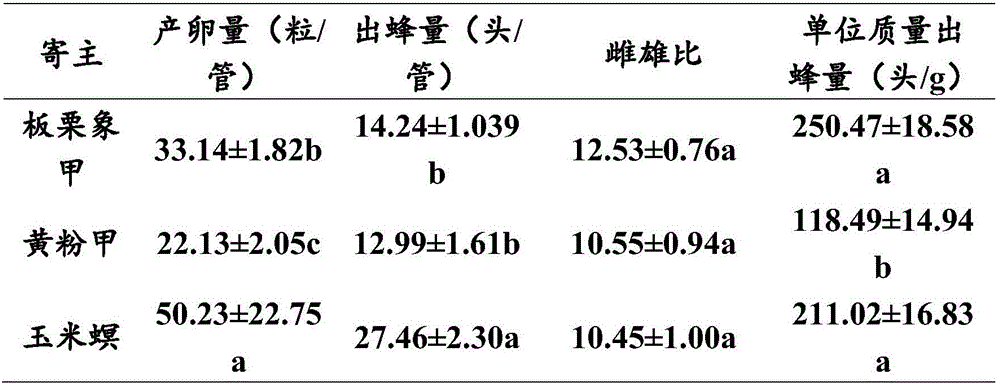A method for the propagation and rejuvenation of scleroderma guani Xiao et Wu with Chinese chestnut weevils as intermediate hosts and the use thereof
A technology for a swollen leg wasp and a host, which is applied in the field of insects, can solve the problems of decreased parasitic ability and population degradation of the tube-type swollen leg wasp, and achieves the effects of simple equipment, reduced reproduction cost, and broad industrialization prospects.
- Summary
- Abstract
- Description
- Claims
- Application Information
AI Technical Summary
Problems solved by technology
Method used
Image
Examples
Embodiment 1
[0036] 1. Instruments and equipment: artificial intelligence incubator.
[0037] 2. Main appliances and consumables: finger tubes, cotton, brushes, trays, tweezers, towels, alcohol.
[0038] 3. Artificial bee breeding host
[0039] Host species: chestnut weevil
[0040] Host collection: collect mature larvae of chestnut weevil as alternative hosts.
[0041] Host storage: store at 10°C for 1 month.
[0042] 1 bee
[0043] 1.1 species of bees get:
[0044] (1) Collect the long beetle worms parasitized by Scleroderma guanii in the field, and place them in the artificial intelligence incubator (26°C, RH 65%, D:L=24), until the tubes on the long beetle worms All Scleroderma sclerodermas develop into adults.
[0045] (2) Purchase healthy individual bees from laboratories or companies that breed Scleroderma guanii.
[0046] Breeding bee selection: choose wingless female bees that are large, strong, lively, and mated.
[0047] Breeding bee propagation: each finger-shaped tube ...
Embodiment 2
[0064] The degenerated Scleroderma guanii was bred for 5 generations with the yellow powder beetle, and the ratio of male to female was selected to be 2:1, and placed in a culture tube. One day after natural mating, one female bee was placed in the same area as a chestnut weevil. In the larvae breeding box, cultured for 2 days in an environment with a temperature of 27°C and a humidity of 70%. Under the microscope, 29 chestnut weevil larvae were seen to lay eggs. After 26 days of culture in a conventional breeding environment, 27 bee cocoons were collected and the cocoons emerged. According to statistics, the average body length of bees is 3.5376±0.3079mm, and the weight is 0.8201±0.1385g, both of which are significantly higher than those of the previous generation.
Embodiment 3
[0066] The degenerated Scleroderma guanii was bred for 4 generations with the yellow powder beetle, and the ratio of male to female was selected to be 3:1, and placed in a culture tube. After natural mating, 3 female bees were placed in the same place as a chestnut weevil. The larvae were cultured in the larva breeding box for 1 day at a temperature of 25°C and a humidity of 55%. Under the microscope, it was seen that the chestnut weevil larvae produced 41 eggs. After 26 days of culture in a conventional culture environment, 41 bee cocoons were collected and the cocoons emerged. According to statistics, the average body length of bees is 3.7012±0.2331mm, and the weight is 0.8137±0.0781g, both of which are significantly higher than those of the previous generation.
PUM
 Login to View More
Login to View More Abstract
Description
Claims
Application Information
 Login to View More
Login to View More - R&D
- Intellectual Property
- Life Sciences
- Materials
- Tech Scout
- Unparalleled Data Quality
- Higher Quality Content
- 60% Fewer Hallucinations
Browse by: Latest US Patents, China's latest patents, Technical Efficacy Thesaurus, Application Domain, Technology Topic, Popular Technical Reports.
© 2025 PatSnap. All rights reserved.Legal|Privacy policy|Modern Slavery Act Transparency Statement|Sitemap|About US| Contact US: help@patsnap.com



